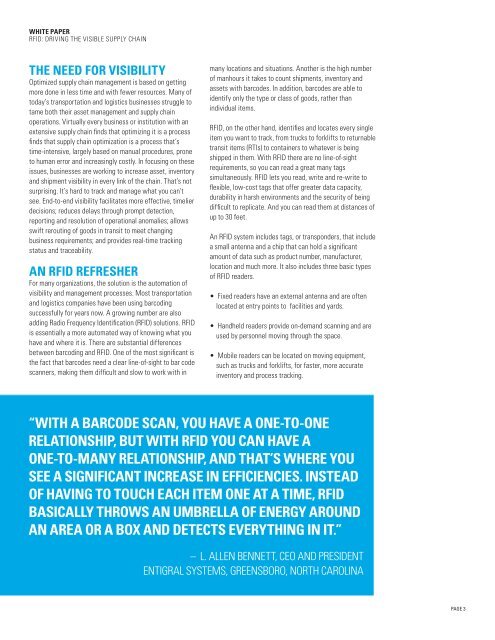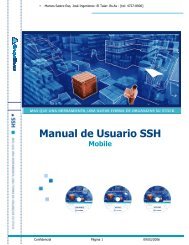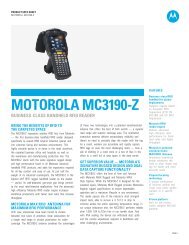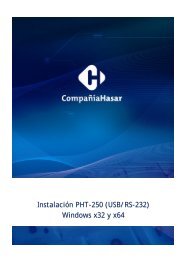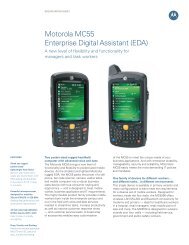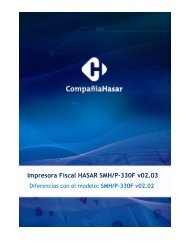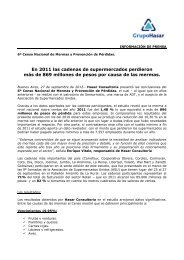Advantages of RFID in Transportation & Logistics - Motorola Solutions
Advantages of RFID in Transportation & Logistics - Motorola Solutions
Advantages of RFID in Transportation & Logistics - Motorola Solutions
Create successful ePaper yourself
Turn your PDF publications into a flip-book with our unique Google optimized e-Paper software.
WHITE PAPER<strong>RFID</strong>: DRIVING THE VISIBLE SUPPLY CHAINTHE NEED FOR VISIBILITYOptimized supply cha<strong>in</strong> management is based on gett<strong>in</strong>gmore done <strong>in</strong> less time and with fewer resources. Many <strong>of</strong>today’s transportation and logistics bus<strong>in</strong>esses struggle totame both their asset management and supply cha<strong>in</strong>operations. Virtually every bus<strong>in</strong>ess or <strong>in</strong>stitution with anextensive supply cha<strong>in</strong> f<strong>in</strong>ds that optimiz<strong>in</strong>g it is a processf<strong>in</strong>ds that supply cha<strong>in</strong> optimization is a process that’stime-<strong>in</strong>tensive, largely based on manual procedures, proneto human error and <strong>in</strong>creas<strong>in</strong>gly costly. In focus<strong>in</strong>g on theseissues, bus<strong>in</strong>esses are work<strong>in</strong>g to <strong>in</strong>crease asset, <strong>in</strong>ventoryand shipment visibility <strong>in</strong> every l<strong>in</strong>k <strong>of</strong> the cha<strong>in</strong>. That’s notsurpris<strong>in</strong>g. It’s hard to track and manage what you can’tsee. End-to-end visibility facilitates more effective, timelierdecisions; reduces delays through prompt detection,report<strong>in</strong>g and resolution <strong>of</strong> operational anomalies; allowsswift rerout<strong>in</strong>g <strong>of</strong> goods <strong>in</strong> transit to meet chang<strong>in</strong>gbus<strong>in</strong>ess requirements; and provides real-time track<strong>in</strong>gstatus and traceability.AN <strong>RFID</strong> REFRESHERFor many organizations, the solution is the automation <strong>of</strong>visibility and management processes. Most transportationand logistics companies have been us<strong>in</strong>g barcod<strong>in</strong>gsuccessfully for years now. A grow<strong>in</strong>g number are alsoadd<strong>in</strong>g Radio Frequency Identification (<strong>RFID</strong>) solutions. <strong>RFID</strong>is essentially a more automated way <strong>of</strong> know<strong>in</strong>g what youhave and where it is. There are substantial differencesbetween barcod<strong>in</strong>g and <strong>RFID</strong>. One <strong>of</strong> the most significant isthe fact that barcodes need a clear l<strong>in</strong>e-<strong>of</strong>-sight to bar codescanners, mak<strong>in</strong>g them difficult and slow to work with <strong>in</strong>many locations and situations. Another is the high number<strong>of</strong> manhours it takes to count shipments, <strong>in</strong>ventory andassets with barcodes. In addition, barcodes are able toidentify only the type or class <strong>of</strong> goods, rather than<strong>in</strong>dividual items.<strong>RFID</strong>, on the other hand, identifies and locates every s<strong>in</strong>gleitem you want to track, from trucks to forklifts to returnabletransit items (RTIs) to conta<strong>in</strong>ers to whatever is be<strong>in</strong>gshipped <strong>in</strong> them. With <strong>RFID</strong> there are no l<strong>in</strong>e-<strong>of</strong>-sightrequirements, so you can read a great many tagssimultaneously. <strong>RFID</strong> lets you read, write and re-write t<strong>of</strong>lexible, low-cost tags that <strong>of</strong>fer greater data capacity,durability <strong>in</strong> harsh environments and the security <strong>of</strong> be<strong>in</strong>gdifficult to replicate. And you can read them at distances <strong>of</strong>up to 30 feet.An <strong>RFID</strong> system <strong>in</strong>cludes tags, or transponders, that <strong>in</strong>cludea small antenna and a chip that can hold a significantamount <strong>of</strong> data such as product number, manufacturer,location and much more. It also <strong>in</strong>cludes three basic types<strong>of</strong> <strong>RFID</strong> readers.• Fixed readers have an external antenna and are <strong>of</strong>tenlocated at entry po<strong>in</strong>ts to facilities and yards.• Handheld readers provide on-demand scann<strong>in</strong>g and areused by personnel mov<strong>in</strong>g through the space.• Mobile readers can be located on mov<strong>in</strong>g equipment,such as trucks and forklifts, for faster, more accurate<strong>in</strong>ventory and process track<strong>in</strong>g.“WITH A BARCODE SCAN, YOU HAVE A ONE-TO-ONERELATIONSHIP, BUT WITH <strong>RFID</strong> YOU CAN HAVE AONE-TO-MANY RELATIONSHIP, AND THAT’S WHERE YOUSEE A SIGNIFICANT INCREASE IN EFFICIENCIES. INSTEADOF HAVING TO TOUCH EACH ITEM ONE AT A TIME, <strong>RFID</strong>BASICALLY THROWS AN UMBRELLA OF ENERGY AROUNDAN AREA OR A BOX AND DETECTS EVERYTHING IN IT.”– L. ALLEN BENNETT, CEO AND PRESIDENTENTIGRAL SYSTEMS, GREENSBORO, NORTH CAROLINAPAGE 3


